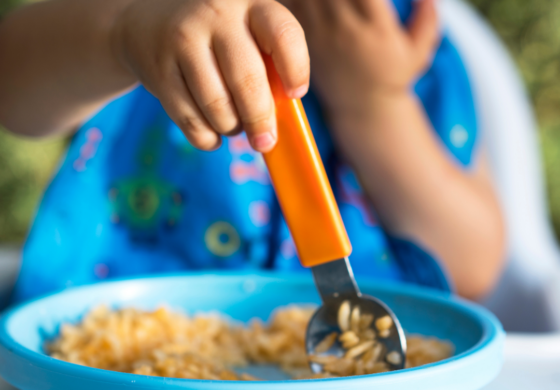The toddler years can be a struggle! Little ones between the ages of 1-3 are going through a significant developmental period of growth during this time, and their language and motor skills are exploding! They’re also becoming more vocal and independent in their wants and needs, and their personality is more prominent than you’d expect for how little they are. With these changes often comes the adamant belief that they will NOT eat the food on their plate (they used to love) because suddenly, it’s *gross* now. Oh, the joys of toddlerhood.
We’d love to support you and provide some ideas for your little picky eater that we’ve learned throughout years of providing feeding therapy for toddlers. These are just a few tips and tricks that may help you and your toddler learn to love food, eating, and mealtime.

Model What You Want Them to Do
When working with toddlers or picky eaters, we’ve found that it’s crucial to be elbow deep in mealtime. Show them how you want them to participate in mealtime and eating by playing. Instead of asking them to touch the pea, show them and tell them, “I’m going to poke the pea with a toothpick!” or “the green ball is going to go down the slide [a paper towel tube] and into the swimming pool [a bowl]!”
If you’ve been around for a while, you know that we’re ALL about playing with our food. Research continues to find that the more a child plays with their food, the more likely they are to put it in their mouth and eat it eventually. If you want them to play with their food, you need to show them that you have fun playing with your food!

Use Positive Language
When faced with feeding difficulty, instead of asking, “Do you want another bite?” or “Do you want to try the chicken?”, ask questions like “Do you want to try the chicken or the sweet potato first?” or “Do you think the apple will be crunchy or soft?”. The language that offers two choices instead of questions that lead to a strong, loud, and adamant “NO!” are often more successful with toddlers!
We know it’s so easy to ask your little one to just take one more bite, but we want to encourage you to move away from this language. Remember, it’s your job as your little one’s grown up to decide what food you provide and when they can eat, and it’s their job to determine if they eat and how much. We never want to force a child to interact with a particular food when they’re not ready to. This will make them more fearful of the feeding environment and the problematic foods for them. As you explore solutions for your toddler’s feeding challenge, we recommend focusing on talking about the sensory properties of food (soft, crunchy, loud, smooth, bumpy, etc.) to learn about the food on their plate without pressure to eat it.
Use a Goodbye Bowl
It’s so crucial that both at home and in feeding therapy, the environment is set up in a way that encourages trust. We’ve found that an effective way to do this is through the use of a goodbye bowl! The bowl is at the table during every mealtime, and your child can put food into it that they don’t want to engage with or eat. Once the food is in the bowl, they don’t need to touch it again! We know what you’re thinking– my child will put everything in the bowl!
In our experience as feeding therapists, we’ve noticed that using a goodbye bowl gives your little one some control over what’s on their plate. And when they move food from their plate to the goodbye bowl, it encourages positive interaction, at some level, with the non-preferred food! You can try to encourage your child to kiss the food goodbye before it goes in the bowl, blow it off their hand, or scrape it off the plate and into the bowl.

Make Very Small Changes to Accepted Foods
If your little one will accept a minimal number of foods, that’s okay! We can increase their acceptance of new foods by building off of foods they already eat. For example, suppose they only will eat one flavor of yogurt from one specific brand. In that case, you could add a few pieces of crushed cereal or (accepted) fruit to the yogurt to change the texture, change the color of the yogurt with food coloring (but keep the flavor the same), or switch to a different brand of yogurt, but pick the same flavor and color that they will eat. Suppose your little one will only eat dinosaur chicken nuggets from a specific brand. In that case, you could offer them dinosaur chicken nuggets but change the texture or appearance justttt slightly, such as removing the breading off the tail only or by cooking them in the microwave instead of the oven. Then move on to providing dinosaur chicken nuggets from a different brand, then circle-shaped chicken nuggets.

Never try to trick your child into these changes– let them see what you’re doing so they aren’t surprised and become more fearful of mealtimes. By offering their preferred foods with slight modifications or with slightly different combinations (such as mixing a preferred fruit with a preferred yogurt), your little one will learn that they can try new things, that it will be okay, and that they might even like it!
If you feel like your little one might benefit from a feeding therapy session, we invite you to book a FREE consultation with one of our amazing OT Feeding Specialists! We are happy to listen to your concerns and help you decide on some of your next steps towards joyful mealtimes!

